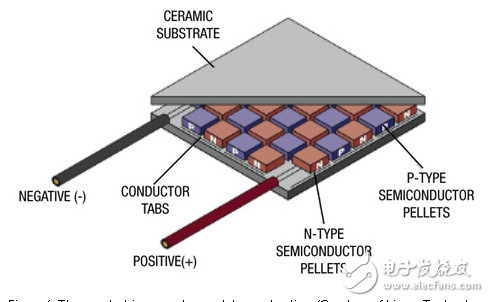
资料下载

Thermoelectric Energy Harvesting
Thermoelectric Energy Harvesting
在自然环境和人造环境中,温度差异几乎无处不在。它们很容易识别,因为它们常常是个人不适的根源。我们在寒冷的日子穿暖和的衣服以减少身体的热量,而暖气和空调则通过调节室内空气温度来满足个人的喜好来提高舒适度。然而,通常不希望出现的温度梯度可以被称为热电效应。
热电效应(TE)已经有近两个世纪的历史了。Thomas Johann Seebeck因发现,不同的金属放在一个温度梯度能够偏转指南针。一种材料或设备产生的每单位温度的电压称为Seebeck系数系数(V /°C表示)。
热电器件最常用的一种制冷热泵通常被称为Peltier coolers。这源于查尔斯的1884部的发现使电流通过一个连接两种金属之间会吸收热量,在另一侧产生热量。
多年来,便携式固态制冷已被证明是非常有用的,尤其是在诸如红外线探测器之类的设备中。然而,由于塞贝克发现,该设备将工作在反向,这是非常有用的在一路收获热能用在微功耗电子。

A sandwich implementing an array of n- and p-type semiconductor legs (Figure 1) creates the typical TE module. The legs are pellets of either bismuth telluride or antimony telluride. The legs are strapped together to create a series electrical connection and a parallel thermal connection. The top and bottom of the module is most often aluminum oxide ceramic to provide electrical insulation and good thermal conductivity.
The Seebeck coefficient of a complete module depends on other factors, but for the raw bismuth telluride material, it can be up to −287 μV/°C for certain compositions. For a complete module with modest dimensions of around an inch square (single-stage modules are between 2 and 5 mm thick), it is possible to produce over 100 mV/°C.
声明:本文内容及配图由入驻作者撰写或者入驻合作网站授权转载。文章观点仅代表作者本人,不代表电子发烧友网立场。文章及其配图仅供工程师学习之用,如有内容侵权或者其他违规问题,请联系本站处理。 举报投诉
- 相关下载
- 相关文章







